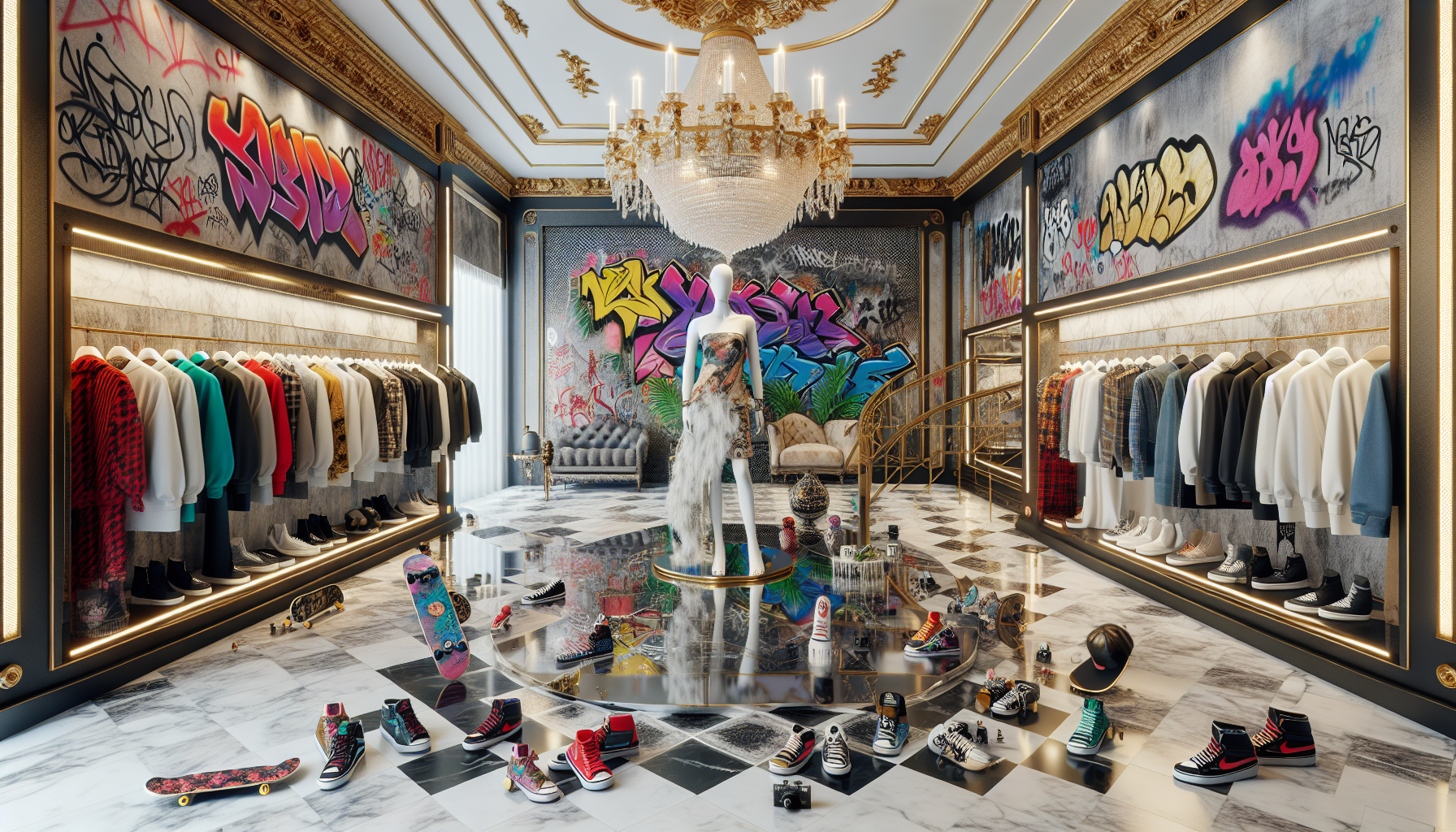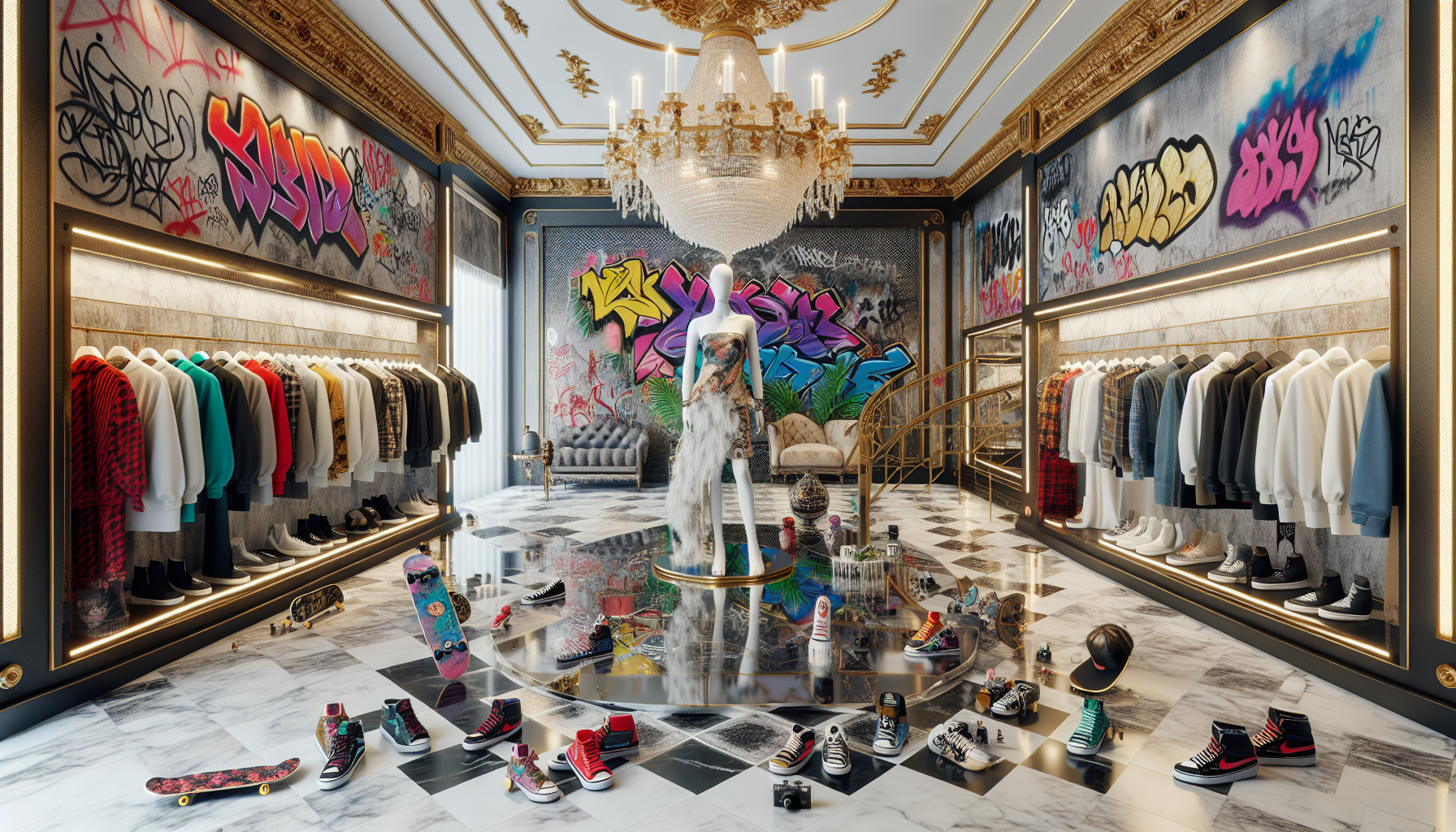
rise of a streetwear icon
Virgil Abloh’s journey from a streetwear enthusiast in the Chicago suburbs to a global fashion icon is a testament to his unique vision and relentless drive. Growing up, Abloh was deeply influenced by the vibrant street culture around him, which sparked his interest in fashion and design. His early exposure to skateboarding and hip-hop culture played a significant role in shaping his aesthetic, which would later become synonymous with his brand.
Abloh’s educational background in civil engineering and architecture provided him with a distinct perspective on design, allowing him to blend functionality with creativity. This fusion of disciplines became evident in his work, as he began experimenting with fashion by creating custom T-shirts and collaborating with local artists and designers. His innovative approach quickly gained attention, setting the stage for his rise in the fashion world.
In 2009, Abloh’s career took a significant turn when he interned at Fendi alongside Kanye West. This experience not only honed his skills but also expanded his network within the industry. It was during this time that Abloh began to develop his own brand, Off-White, which would become a pivotal platform for his streetwear vision. Off-White’s distinctive use of quotation marks, bold graphics, and industrial motifs resonated with a global audience, propelling Abloh into the spotlight.
Abloh’s ability to seamlessly blend high fashion with streetwear challenged traditional fashion norms and attracted a diverse following. His designs were not just about clothing; they represented a cultural movement that celebrated individuality and authenticity. As his influence grew, Abloh became a symbol of innovation and disruption in the fashion industry, paving the way for a new generation of designers who dared to think outside the box.
breaking barriers in fashion
Virgil Abloh’s impact on the fashion industry was marked by his ability to transcend conventional boundaries and redefine what fashion could be. His work was characterized by a fearless approach to blending different cultural influences, which allowed him to break down the barriers between streetwear and high fashion. Abloh’s designs often incorporated elements from various subcultures, creating a unique aesthetic that resonated with a wide audience.
One of Abloh’s most significant contributions to fashion was his commitment to inclusivity and diversity. He challenged the industry’s status quo by advocating for representation and creating opportunities for underrepresented groups. Abloh’s collaborations with artists, musicians, and other designers were not just about merging styles but also about fostering a sense of community and collaboration. This approach helped to democratize fashion, making it more accessible and relatable to people from all walks of life.
Abloh’s tenure at Off-White was marked by a series of groundbreaking collaborations with major brands such as Nike, IKEA, and even Evian. These partnerships were not just commercial ventures; they were creative experiments that pushed the boundaries of what fashion could achieve. By working with brands outside the traditional fashion sphere, Abloh was able to introduce his innovative ideas to new audiences and further blur the lines between different industries.
His work was also characterized by a deep understanding of the power of branding and marketing. Abloh’s use of social media and digital platforms allowed him to connect directly with his audience, creating a sense of intimacy and immediacy that was rare in the fashion world. This direct engagement with consumers helped to build a loyal following and solidify his status as a cultural icon.
Through his fearless experimentation and commitment to breaking down barriers, Virgil Abloh not only changed the way fashion was perceived but also inspired a new generation of designers to challenge the norms and create their own paths in the industry. His legacy is one of innovation, inclusivity, and a relentless pursuit of creativity.
legacy at Louis Vuitton
Virgil Abloh’s appointment as the artistic director of Louis Vuitton’s menswear in 2018 marked a historic moment in the fashion industry. As the first African-American to hold such a prestigious position at the French luxury house, Abloh’s tenure was not just a personal achievement but a significant step towards greater diversity and representation in high fashion. His presence at Louis Vuitton symbolised a shift in the industry’s landscape, where traditional boundaries were being redefined.
Abloh’s approach to his role at Louis Vuitton was characterised by a seamless blend of luxury and streetwear, a testament to his unique vision. He brought his signature style to the brand, infusing it with a modern, youthful energy that resonated with a new generation of consumers. His collections often featured bold graphics, vibrant colours, and unexpected materials, challenging the conventional notions of luxury fashion.
One of Abloh’s most notable contributions to Louis Vuitton was his ability to create narratives through his collections. Each runway show was a carefully curated experience, often drawing inspiration from his personal journey and cultural influences. Abloh’s storytelling approach allowed him to connect with audiences on a deeper level, making fashion more than just about clothing but about shared experiences and emotions.
Abloh’s impact extended beyond the runway, as he actively sought to mentor and uplift emerging designers from diverse backgrounds. He understood the importance of creating opportunities for the next generation and used his platform to advocate for change within the industry. His commitment to fostering talent and promoting inclusivity left a lasting imprint on Louis Vuitton and the broader fashion world.
Throughout his tenure, Abloh’s work at Louis Vuitton was celebrated for its innovation and cultural relevance. He successfully bridged the gap between luxury and streetwear, creating a new paradigm for what high fashion could be. His legacy at Louis Vuitton is one of transformation, where he not only redefined the brand’s aesthetic but also paved the way for a more inclusive and dynamic future in fashion.
journey from chicago suburbs to high fashion
Virgil Abloh’s journey from the Chicago suburbs to the pinnacle of high fashion is nothing short of extraordinary. Born to Ghanaian immigrant parents, Abloh’s early life was steeped in a blend of cultural influences that would later inform his unique design perspective. Growing up in Rockford, Illinois, he was far removed from the traditional fashion capitals, yet his passion for creativity and design was evident from a young age.
Abloh’s academic pursuits took him to the University of Wisconsin-Madison, where he earned a degree in civil engineering, followed by a master’s in architecture from the Illinois Institute of Technology. This unconventional educational path laid the groundwork for his innovative approach to fashion, blending structural precision with artistic flair.
His entry into the fashion world was marked by a pivotal internship at Fendi in 2009, alongside rapper Kanye West. This experience was instrumental in shaping his career, providing him with invaluable insights into the luxury fashion industry. Abloh’s ability to merge streetwear aesthetics with high fashion sensibilities quickly garnered attention, leading to the launch of his own label, Off-White, in 2013.
Off-White’s success was a testament to Abloh’s vision, as he seamlessly integrated urban culture with luxury fashion, challenging traditional norms and resonating with a new generation of fashion enthusiasts. His groundbreaking work caught the eye of Louis Vuitton, and in 2018, he was appointed as the artistic director of menswear, making history as the first African-American to hold this prestigious position.
Abloh’s ascent in the fashion world is a narrative of breaking barriers and redefining what it means to be a designer in the modern era. His journey from the suburbs to the global stage is a source of inspiration, illustrating the power of creativity and determination in transforming the fashion landscape.
redefining luxury with streetwear influence
Virgil Abloh’s influence on the luxury fashion industry is nothing short of revolutionary, as he boldly redefined the boundaries between streetwear and high fashion. His approach was not merely about blending two distinct styles but about creating a new language of luxury that resonated with a diverse and global audience. Abloh’s work at Louis Vuitton exemplified this ethos, where he infused the brand’s storied heritage with a fresh, urban sensibility.
Abloh’s designs often featured bold graphics, unexpected materials, and a playful yet sophisticated aesthetic that challenged the traditional notions of luxury. He was known for his ability to transform everyday items into coveted fashion pieces, elevating streetwear staples like hoodies and sneakers to the realm of high fashion. This approach not only broadened the appeal of luxury brands but also democratized fashion, making it more accessible to younger, more diverse consumers.
His collaborations with various brands and artists further cemented his status as a cultural innovator. By partnering with companies like Nike and IKEA, Abloh demonstrated that luxury could be both aspirational and attainable, bridging the gap between exclusivity and inclusivity. His work was a testament to the power of collaboration and the importance of cultural exchange in the fashion industry.
Abloh’s impact extended beyond design; he was a vocal advocate for diversity and inclusion within the fashion world. He used his platform to highlight underrepresented voices and championed initiatives that supported emerging designers from diverse backgrounds. His commitment to fostering a more inclusive industry has left a lasting legacy, inspiring a new generation of creatives to challenge the status quo and redefine what luxury means in the modern era.
In Australia, where fashion is a vibrant mix of influences, Abloh’s work resonates deeply. His ability to blend global trends with local sensibilities speaks to the heart of Australian fashion, which thrives on innovation and individuality. As the fashion landscape continues to evolve, Abloh’s legacy serves as a reminder of the transformative power of creativity and the endless possibilities that arise when boundaries are pushed.
